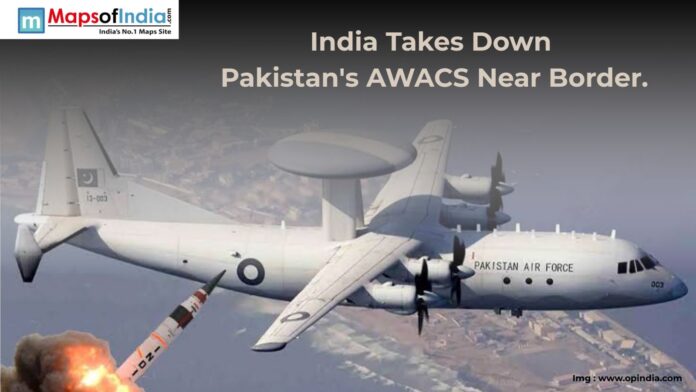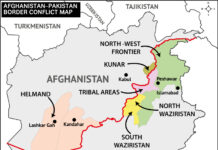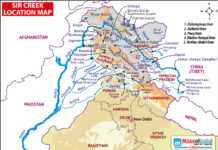
Introduction
In a stunning display of air superiority, India recently shot down a Pakistani Airborne Warning and Control System (AWACS) aircraft near the Indo-Pakistan border. This marks a significant escalation in the ongoing airspace rivalry between the two nuclear-armed neighbors. AWACS, essential for providing early warning and surveillance, are a key component of modern aerial warfare, and their destruction not only disrupts military operations but also sends a powerful message regarding India’s advanced defense capabilities.
This blog post delves into the incident’s details, its strategic implications, and the broader geopolitical context. We will explore the importance of AWACS in modern warfare, the significance of the downing of Pakistan’s aircraft, and the potential consequences of this high-stakes event on India-Pakistan relations.
What is AWACS?
An Airborne Warning and Control System (AWACS) is a type of radar system mounted on an aircraft that provides long-range surveillance, detection, tracking, and target identification. AWACS are designed to detect incoming aircraft, missiles, and other threats at great distances, giving the operator the ability to make tactical decisions well in advance of a potential conflict. The AWACS platform is used for command and control, particularly in high-intensity combat situations, and is a critical asset for air forces around the world.
Both India and Pakistan have been investing in AWACS technologies to bolster their defense capabilities, especially in the context of their ongoing rivalry. India’s fleet of AWACS, including the DRDO-developed AEW&CS (Airborne Early Warning and Control System), is integrated into its broader defense strategy, which emphasizes rapid reaction and strategic deterrence.
The Incident: A Detailed Account
On the morning of the attack, Indian radar systems picked up an unidentified aircraft flying dangerously close to the border. Initial reports suggested it was a Pakistani AWACS, deployed to monitor Indian air movements and gather intelligence. The aircraft was spotted flying at an altitude well within India’s air defense zone, sparking immediate concerns about its intent.
Indian Air Force (IAF) fighter jets were quickly scrambled to intercept and identify the aircraft. As the AWACS crossed deeper into Indian-controlled airspace, it was confirmed that the aircraft was Pakistani. Indian pilots, adhering to standard operational procedures, issued several warnings for the aircraft to return to Pakistani airspace. When these warnings were ignored, the IAF took the decision to engage the AWACS.
In a carefully coordinated operation, Indian fighter jets fired surface-to-air missiles, successfully bringing down the Pakistani AWACS. The aircraft crashed on Pakistani territory, and debris was later recovered by Pakistani forces. According to reports, all crew members aboard the AWACS perished in the attack, though Pakistan has not publicly acknowledged the loss as of the latest updates.
The Significance of Shooting Down Pakistan’s AWACS
1. A Blow to Pakistan’s Air Surveillance Capabilities
AWACS are vital for providing situational awareness during aerial operations, especially in a high-stakes region like South Asia. Pakistan’s loss of an AWACS significantly hampers its ability to detect and track Indian aerial movements, leaving its airspace vulnerable to surprise attacks and making it difficult for Pakistan to mount an effective response in the event of an escalation.
For India, the downing of the AWACS sends a clear message about the superiority of its air defense systems and its willingness to protect its airspace at all costs. This strategic advantage, particularly in a region marked by decades of tension, positions India to maintain control over its borders and engage in proactive defense measures.
2. The Role of Air Superiority in Modern Warfare
The destruction of Pakistan’s AWACS highlights the critical importance of air superiority in modern warfare. In an age where aerial combat and surveillance play a pivotal role, the ability to control the skies often determines the outcome of military conflicts. The Indian Air Force’s success in downing a sophisticated radar system like the AWACS is a testament to the technological advancements and strategic thinking behind India’s defense capabilities.
By neutralizing an AWACS, India not only disrupts Pakistan’s surveillance network but also undermines its ability to respond effectively to any airstrikes or aerial incursions. This victory further strengthens India’s position as the dominant military force in the region.
3. Geopolitical Consequences and Diplomatic Fallout
The downing of the AWACS has serious diplomatic and geopolitical implications. While India’s defense action is being hailed as a successful operation, the move could lead to heightened tensions between the two countries. In the short term, Pakistan may seek to retaliate, possibly through aerial strikes or other forms of military escalation. This could risk plunging the region into a full-scale conflict.
India, on the other hand, is likely to present the downing of the AWACS as a defensive measure aimed at protecting its sovereignty. The incident may prompt India to strengthen its military posture along the border and seek additional support from global allies, especially the United States, which has a vested interest in maintaining stability in the region.
4. Impact on the Global Strategic Balance
Beyond India and Pakistan, the downing of the AWACS could have repercussions for the broader South Asian security environment. Both countries possess nuclear weapons, and any escalation between them carries the potential for devastating consequences. The incident serves as a reminder of the fragile security dynamics in the region and the need for responsible diplomatic engagement to prevent further escalation.
International actors such as China, the United States, and Russia are likely to monitor the situation closely. China, a close ally of Pakistan, may offer diplomatic or military support to its partner, while the United States and other Western nations may urge both sides to exercise restraint.
India’s Response: Strategic Implications
India’s swift action in neutralizing Pakistan’s AWACS demonstrates its growing confidence in its military capabilities and its willingness to take decisive action when its airspace is threatened. The IAF’s response, though calculated, also sends a strong message to Pakistan: India will not hesitate to defend its territorial integrity using any means necessary.
The event also underscores the importance of India’s investment in air defense technologies, including surface-to-air missiles, fighter aircraft, and early warning systems. The success of this operation is a clear reflection of India’s advanced military infrastructure and its ability to effectively counter emerging threats.
1. Strengthening Border Security
In the wake of the AWACS downing, India is expected to bolster its border security measures, particularly in areas prone to aerial incursions. The Indian Air Force will likely conduct more frequent surveillance and intelligence-gathering operations to detect any further Pakistani attempts to breach Indian airspace.
Additionally, India may look to enhance its counter-aircraft capabilities, especially in regions like Jammu and Kashmir and Rajasthan, where the risk of aerial incursions is high.
2. Domestic and International Reactions
Domestically, the downing of Pakistan’s AWACS is expected to be viewed as a major success for India’s defense establishment. The Indian government is likely to highlight this achievement in its ongoing efforts to project India as a global power with a robust defense system. The incident may also be used as a talking point in upcoming elections to demonstrate the ruling government’s commitment to national security.
On the international stage, India’s actions could be perceived as a demonstration of strength. This may attract both support and condemnation, with some countries praising India’s decisiveness, while others, particularly in the Middle East, may criticize the escalation of hostilities in the region.
The Future of India-Pakistan Air Defense Strategies
The downing of Pakistan’s AWACS signals a new phase in India-Pakistan military dynamics. Both nations will likely continue to prioritize strengthening their air defense capabilities, with a particular focus on anti-aircraft technologies, radar systems, and surveillance platforms. As both countries enhance their respective arsenals, it is possible that future military engagements could see more advanced tactics and technologies employed.
This incident may also encourage India and Pakistan to revisit their air defense strategies, potentially leading to an arms race in the skies. Diplomatic solutions, including dialogue and confidence-building measures, will be essential in managing the evolving security situation.
Conclusion
India’s successful downing of Pakistan’s AWACS near the border is a landmark event that highlights the escalating rivalry between the two countries. The incident underscores the critical role of air superiority in modern warfare and serves as a reminder of the high stakes involved in the South Asian security landscape. With both countries possessing nuclear weapons and advanced military technologies, it is essential for global powers to encourage dialogue and restraint in order to avoid a full-scale conflict.
The downing of the AWACS is a testament to India’s growing defense capabilities and its resolve to protect its sovereignty at all costs. While the geopolitical consequences of this event remain to be seen, one thing is certain: the strategic balance between India and Pakistan has shifted once again, and the world will be watching closely as this high-stakes rivalry unfolds.



